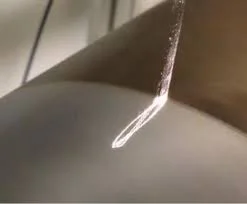At some point in the course of work, your metallic tools might suffer chronic rust. Or just stubborn dust that doesn’t seem to wash off. Sometimes you realize the grease and oil have stuck onto your otherwise shiny stainless steel tools. And other times it’s yearslong soot sticking around your walls. Whichever speaks to your situation, it’s not comfortable. You end up asking yourself questions like “Will I ever get my stainless steel back to stainless?”
And even though you’ve heard about laser cleaning, you might have reservations. The likes of it may be too expensive. Or it may rip apart your wall. The list of questions running through your head might be endless. But in this article, we’re out to answer most of these questions. We’ll give you practical answers so you can restore the smile you once had around your workspace.
- How does laser cleaning work?
Laser cleaning is a type of advanced surface-cleaning technology that uses laser beams. The laser machine emits laser beams (high-speed energy rays) and focuses it on the targeted surface. The beam then heats, vaporizes, and eventually blows away the material in question.
On a deeper note, the surface to be cleaned might have contaminants like dust, soot, coatings, etc. The metal has a different density from the contaminants, hence, they have a lower ablation threshold. Meaning they will heat up and vaporize faster than the metal surface, leaving it clean.
- Is laser cleaning eco-friendly?
Yes! The process involves vaporization of the contaminants and ablation. Meaning, the particles are vaporized rather than trashed in their full, toxic form. This reduces the waste size, or trash burden that industries have to go through when cleaning metals.
That being said, many companies are shifting to laser cleaning.
- Can a laser cleaner damage the substrate?
The chances of causing damage to the substrate are minimal if you know how to operate the machine. Laser cleaning machines are non-contact with the substrate, which reduces the chances of accidents as well. Meaning, the substrate will always be at a safe distance from the eye of the beam. Also, the process can always be safe if you know which ablation threshold you’re working with.
- What are the types of laser cleaning techniques?
Pulse laser cleaning: They use pulsed laser to break down dirt. The technique adopts an oscillation cleaning method, hence, causing less harm to the substrate. Consequently, pulsed laser machines are a few folds more expensive than continuous laser machines. With a relatively slower cleaning speed, it is suitable for small areas and thick coats.
Continuous laser cleaning: They use continuous laser and high-temperature burning to clean dirt. That could damage the substrate, hence, these machines have a lower asking price. However, they have high-speed, large-area, thin-thick stain cleaning capabilities. They’re also known for good effect cleaning
- Which materials can be good substrates for laser cleaning?
Below are some of the most suitable materials to laser clean:
- Steel
- Cast iron
- Stone
- Aluminum
- Plastics
- Composits
- Wood
- Inox
- Can paint be removed by laser cleaning?
Yes! Laser cleaning is a fine-tuned process that ensures materials to be cleaned come out without aggressive action. The lack of aggressive action allows the substrate to remain clean without having any scrap or heating effects. Other processes of cleaning will remove the paint but increase the scrap rate. Hence, they reduce the overall quality of the substrate.
- Can laser clean away metal?
No! Instead, it removes metal oxides like rust. With this method, you don’t have to break your back from scouring away stubborn rust. You also won’t have to brush off corrosion from bare metal. Laser cleaning allows you to have a safe, convenient, and fast cleaning process.
- Is laser cleaning safer than sandblasting?
Yes! Laser cleaning is safe for both the operator and colleagues. Since the method is non-conductive, you’d hardly have burns or cuts of any kind. Also, it is environmentally friendly as the waste is turned into vapor.
Sandblasting is not the safest cleaning option. It causes noise, air, and environmental pollution. While the process is regarded as affordable, it may not be safe for the operator and other employees.
- What type of laser kills bacteria?
Commonly called LBR, Laser Bacteria Reduction is a cleaning procedure employed during routine cleanings in dentistry. The laser is focused on the gingival pockets of the teeth to prevent gum disease.
- Can laser clean glass surfaces?
Yes! Laser cleaning has versatile applications including glass cleaning. Such laser machines include the N2 laser, which is used to clean the opposite side of the laser. However, glass laser cleaning is limited, depending on the glass composition.
Conclusion
Laser cleaning has multiple industry applications. Each of the applications has been slightly adjusted to fit the special needs of the industry. Such industries include aerospace, medicine, tool manufacturing, shipbuilding, etc. Get your laser machine here today and unlock a rust-free work experience.

